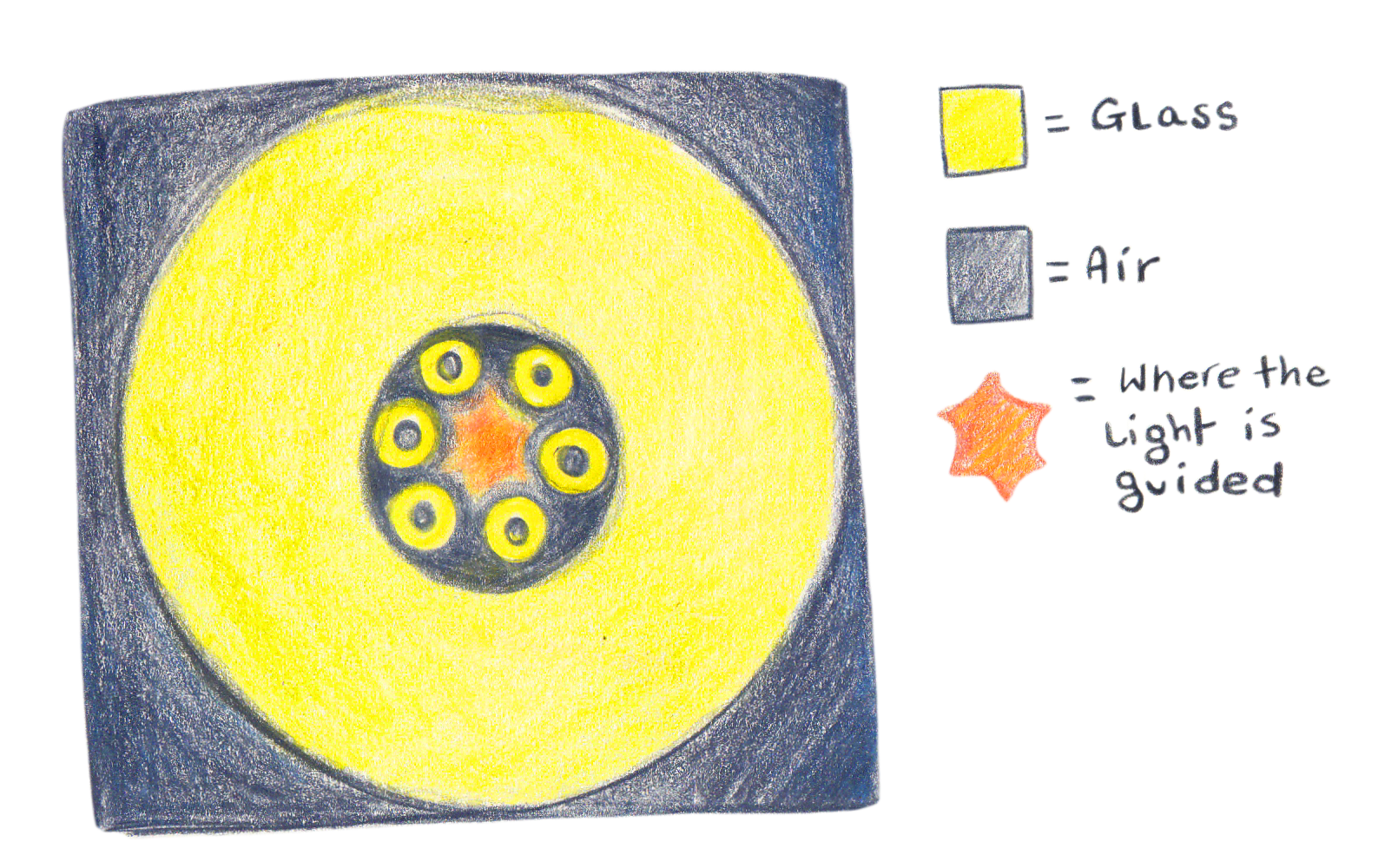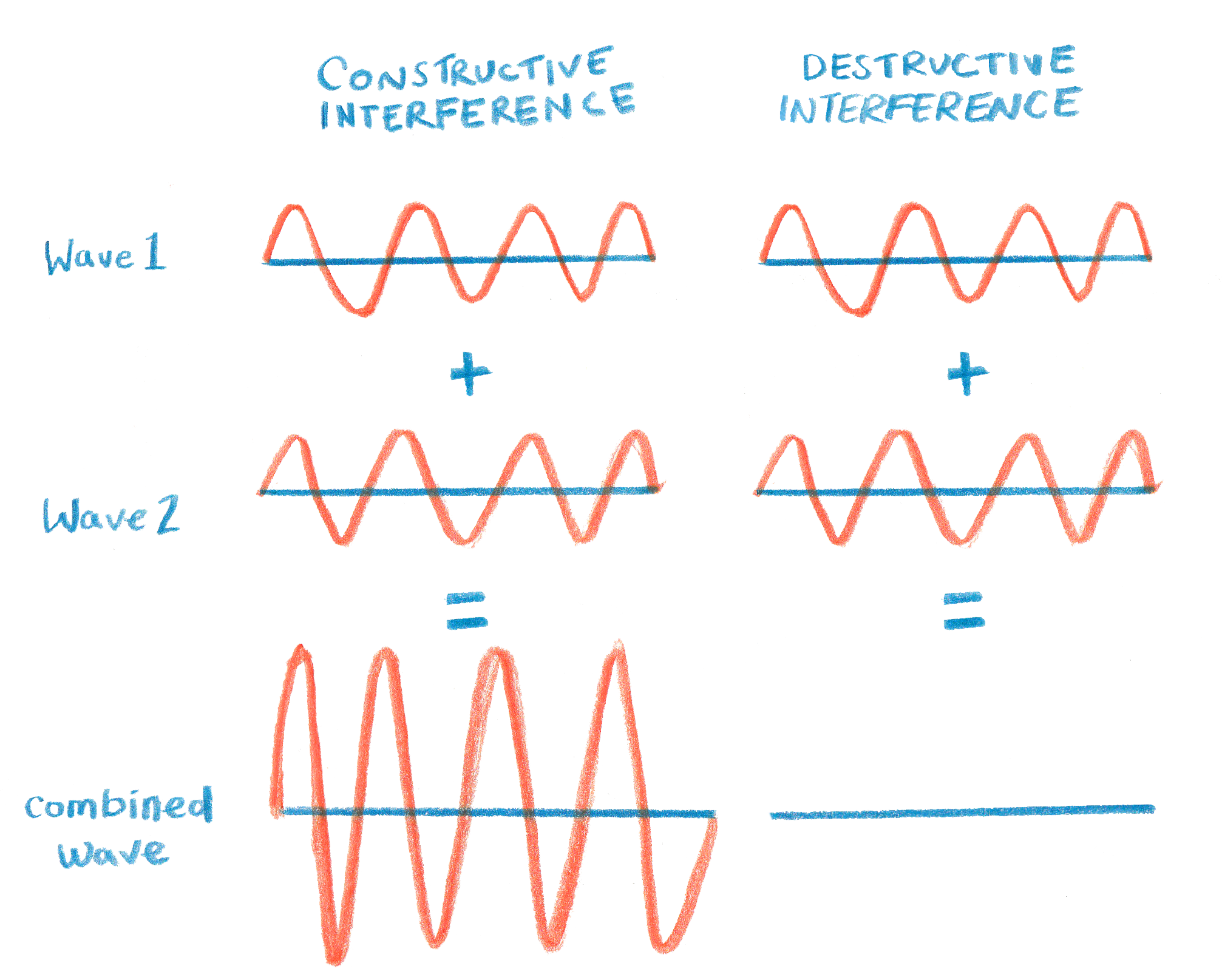What exactly are HCFs?
Where is the guided light in a tubular hollow core fibre
When light comes out from the end of a fibre, it looks like a blobbly thing that stretches in the hollow centre of the cross section (fig.1).
Here we can only see the light being guided by the fibre and not any of the glass structure because there's no light there, and no reflected light to see it with. We only see the guided light in the hollow core.
fig.1
When we can see the glass structure AND the light in the centre of the fibre (i.e. we put the end of the fibre under a microscope with a light source going into the other end of the fibre) it looks like this (fig.2).
The central orange, roughly hexagonal blob is where the light is guided, and you see there the area inside the surrounding tubes is dark, as there is little to no light in them. Black is air, and the yellow stuff is glass.
fig.2
What the tubes for then?
First we need to think about SOLID core fibres, which work rather differently. You might wonder why we cover solid core fibres at all when thinking about how HCFs work, but solid core came first so a lot of conventional terminology and 'thinking' will revolve around them.
A solid core fibre cross section looks like this (fig.3). The slightly lighter central region is called a 'core', and the surrounding area is called 'cladding'. Like before, guided light should be in the core.
fig.3
How light is guided is by total internal reflection (TIR)?
https://www.youtube.com/watch?v=NAaHPRsveJk
Essentially the boundary between two transparent materials that have different speeds of light (refractive index) the light can bend more when travelling through, until it bends so much more that it has to reflect back like a mirror. This is how you get the old 'bouncy, bouncy light' picture (fig.4).
fig.4
But only for some angles going into the fibre which will mean the angle at the boundary allows for TIR, hence the cone of acceptance.
Now with Hollow core fibre, this is inside out.
The guidance mechanisms are quite different. HCF has an additonal parts, which can make it more complicated to immediately understand if new. For TIR, the refractive index of the centre core has to be higher than the cladding refractive index. So TIR won't happen.
So how does the light stay in? First, we need to think about the superposition of light. This basically means to add or subtract waves from another. Adding two big numbers make a big number, adding two zeros will make zero. Now imagine 'lining' up a series of numbers that have positions. When we are adding waves, we are just adding or subtracting numbers that have a position.
Many people know light travels in straight lines so will imagine it as so, a ray of light that goes from one point to another. This is correct and good enough for understanding some scenarios, for example how does light enable us to see? How do mirror reflections work? How do lenses work. But for understanding other scenarios we need to understand light as a wave.
Imagine your light ray as an arrow, and now imagine a wave that travels along it (fig.5):
fig.5
Imaging light as a wave allows us to understand how they interfere with each other. If two waves cross over, they will change shape. If a peak hits a peak, you get a bigger peak, and likewise with a dip (fig.6).
fig.6
We can then imagine adding the waves and see that the combined waves can give waveforms with higher amplitudes (constructive interference) and if we add two equally sized waveforms, but they align peaks with dips, you get destructive interference, so no light.
This gif shows two-point sources (like a light bulb) next to another. You can see how the waveforms aren't simple circles propagating out, but constructive and destructive:
https://en.wikipedia.org/wiki/File:Two_sources_interference.gif
Now how can two waves cross over? One way to do it is to have reflection. If we have an air glass boundary, we will get reflection at the boundary (fig.7).
fig.7
Now add another boundary, back to air (fig.8). You now have a 'Fabry Perot cavity'. The name doesn't matter, the important thing to take away here is if the glass is a certain thickness, then NO light can be transmitted through it. So the light is reflected back because it has to go somewhere.
fig.8
Ever wondered why bubbles are so colourful?
It's because there are air, water + soap, air boundaries of different thickness. Different colours of light will have different thicknesses needed to determine whether they can or can't be transmitted. So some colours make it through, and some are reflected back and so we see them at that part of the bubble (fig.9).
fig.9
A close up of similar phenomena (fig.10).
The black circle has complete destructive interference of all the wavelengths/colours of light present in the source. For this to happen the thickness of the medium, like glass, needs to be very thin! 100s of nanometers thin.
fig.10
Finally, we can come back to Hollow core fibre. Lets revisit it.
The circles of glass (fig.11) are providing the very thin glass structures needed. We blow up the outer rings just like a very long cylindrical bubble, to make thin structures that will cause the light to be reflected rather than transmitted, so that the light stays inside.
fig.11













